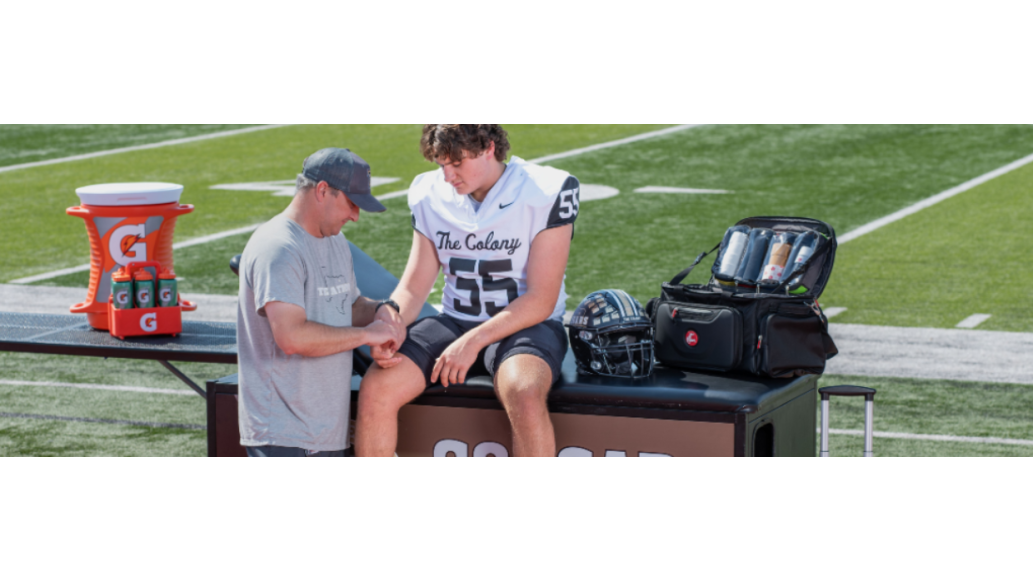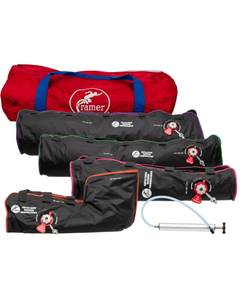In athletics, achieving peak performance is seldom a solo effort; it depends on dedicated professionals focused on athletes' holistic well-being. Athletic trainers (ATs) are crucial in this teamwork, specializing in injury prevention and enhancing athletic performance. They are vital for athletes' success, offering personalized training and recovery protocols.
As sports evolve through advancements in technology, nutrition, and training, ATs must adapt to athletes' needs. This blog explores their essential contributions and expertise, highlighting how ongoing education and modern practices enhance their skills, making them indispensable partners in striving for excellence.
For athletes, working with a skilled AT means forming a reliable ally in their performance journey. Athletic trainers help athletes reach goals while prioritizing health through custom conditioning programs, sound nutritional advice, and innovative recovery methods.
This blog will show how ATs can elevate athlete performance by mastering essential practices and integrating the latest advancements, fostering a culture of excellence that prepares athletes to compete and thrive.
Fundamentals of Education in Athletic Training Enhance Performance Optimization
The foundation of athletic training is predicated upon several critical educational domains, each contributing significantly to enhancing overall athletic performance. The entry-level knowledge and skills required for ATs are delineated by the National Athletic Trainers' Association (NATA) at the following links.
Athletic Training Education PDF
Athletic Training Education Competencies PDF
This level of training provides ATs with the requisite knowledge and skills essential for supporting athletes in various aspects of their performance, including:
- Injury and Illness Prevention/Wellness Promotion
- Assessment and Diagnosis
- Therapeutic Intervention
- Nutrition and Performance
- Recovery Strategies
ATs' extensive training equips them to enhance athletic performance across various aspects. By preventing injuries, diagnosing issues, administering therapies, understanding nutrition, and implementing recovery strategies, they become essential to athletes' development. This expertise helps athletes meet performance goals while promoting their health and longevity in sports. This holistic approach highlights ATs as vital partners in achieving sports success.
Current Issues in Athletic Performance
In the evolving realm of sports medicine, ATs are increasingly embracing numerous emerging trends and significant issues that substantially influence athlete performance. As these focal areas continue to evolve, ATs are at the forefront of integrating innovative methodologies and technologies into their practice, consequently enhancing the support they provide to athletes.
Recovery science has gained attention as researchers and practitioners highlight its importance in athletic performance and injury prevention. ATs apply specialized rehabilitation methods for individual athletes, employing techniques like cryotherapy, contrast baths, and pneumatic compression to aid muscle repair and reduce fatigue. They also educate athletes on these methods and their benefits, integrating them into training. This approach helps athletes achieve peak performance while ensuring proper recovery for long-term sustainability.
A key focus is optimizing sleep, vital for recovery and performance. ATs are aware of sleep's significant impact on physical and mental health, affecting reaction time and morale. They educate athletes on effective sleep hygiene and maintaining consistent schedules. Many use technology, like sleep trackers, to monitor sleep patterns. By equipping athletes with sleep quality strategies, athletic trainers enhance training outcomes and competitiveness.
The link between mental health and performance has gained attention alongside rising pressures on athletes. ATs play a crucial role in supporting athletes' mental well-being through various interventions. They work with sports psychologists to address psychological aspects and promote resilience and stress management. This method emphasizes the importance of mental resilience equal to physical training, improving performance.
Technology in biomechanics and data analytics is transforming athletic trainers' methods for evaluating and enhancing performance. Wearable tech and motion analysis systems help collect data on athletes' movement, identify inefficiencies, and assess injury risks. Analyzing this data, athletic trainers create tailored training and rehab programs, improving individual performance and informing recovery protocols.
Moreover, technology enhances athlete development. Athletic trainers explore tools like virtual reality for immersive experiences and AI for personalized coaching. These innovations offer unique training methodologies that improve skills, technique, and tactical awareness, modernizing the training experience.
Nutritional strategies are vital for enhancing performance, so athletic trainers adopt a holistic approach to nutrition. They emphasize the need for adequate nutrition for energy in rigorous activities, collaborating with athletes on personalized nutrition plans for macronutrients, hydration, and timing. Athletic trainers also educate on supplements and provide guidance on safe and effective options for performance enhancement.
These challenges illustrate ATs' commitment to advancing their practice and supporting athletes' well-being. Engaging in these areas refines their expertise and empowers athletes to reach their potential, fostering health, performance, and longevity in a competitive environment.
The Significance of Educational Opportunities and Certifications for Athletic Trainers
In sports medicine, continuous education and specific qualifications are crucial for ATs aiming to boost athlete performance. These development pathways keep athletic trainers informed of the latest research, technology, and best practices. As sports science evolves, understanding various training regimens, recovery strategies, and injury prevention becomes vital. Educational opportunities allow athletic trainers to refine their skills and enhance athlete performance.
Obtaining certifications in strength and conditioning or exercise physiology broadens athletic trainers' competencies and improves effectiveness. Certified trainers can offer advanced training programs that enhance performance while ensuring safety. This expertise helps athletic trainers create tailored regimens for athletes' unique needs, ultimately boosting performance.
Moreover, continuing education promotes a culture of lifelong learning among athletic trainers, improving adaptability and integration of evidence-based methods into their practice. By embracing new techniques, athletic trainers can better support their athletes, addressing both physical and psychological performance aspects. Continuing education is essential for developing the expertise needed to navigate the complexities of athlete performance. Ultimately, those who prioritize education become distinguished professionals and advocates for their athletes' health and success.
Conclusion: Championing Athletic Performance Through Comprehensive Athletic Training
As we navigate the complexities of contemporary sports medicine, the role of ATs emerges as a fundamental component of athlete success and well-being. Far exceeding the functions of mere first responders or injury alleviators, ATs adopt a comprehensive approach to athlete care that incorporates preventive strategies, performance enhancement, recovery protocols, and psychological support. Through their involvement with pertinent issues—encompassing recovery science, sleep optimization, the integration of technology, and nutritional strategies—ATs are not only influencing the future of athlete performance but are also redefining their own positions within the realm of sports.
The continuous pursuit of education and specialization underscores the commitment of ATs to their profession and the athletes they serve. Through the acquisition of additional credentials and engagement with the latest advancements, ATs augment their expertise, enabling them to develop tailored solutions that cater to the specific needs of individual athletes. This devotion to lifelong learning positions them as trusted allies, uniquely prepared to cultivate resilience, optimize performance, and enhance recovery.
As the field of athletic training continues to evolve, the potential to profoundly influence the athletic experience concurrently advances. By maintaining a leading position in innovative practices and state-of-the-art research, ATs can promote a culture of excellence that permeates every facet of an athlete's journey—from training and performance to recovery and well-being. This comprehensive approach not only optimizes the potential of each athlete but also supports their health and longevity in the realm of sports.
In essence, the collective endeavors of ATs are inherently collaborative, fostering an environment where athletes are empowered to thrive. They function as advocates, educators, and strategists, ensuring that athletes are prepared not merely to compete but to excel in a sustainable manner. Through their unwavering dedication, ATs will persist in shaping the future of sports performance, enhancing the lives of athletes, and contributing to the dynamic landscape of competitive athletics. United, we can propel this essential work forward, championing the health, performance, and success of athletes globally.
Champion Essentials – Products Every AT Needs


References
- https://www.nata.org/sites/default/files/education-overview.pdf
- https://www.nata.org/sites/default/files/competencies_5th_edition.pdf
- https://www.acsm.org/docs/default-source/nyshsi_resources/resources/sssi_post_exercise_recovery-2-1.pdf
- Barnett A. Using recovery modalities between training sessions in elite athletes: does it help? Sports Med. 2006;36(9):781-96. doi: 10.2165/00007256-200636090-00005. PMID: 16937953.
- Charest J, Grandner MA. Sleep and Athletic Performance: Impacts on Physical Performance, Mental Performance, Injury Risk and Recovery, and Mental Health. Sleep Med Clin. 2020 Mar;15(1):41-57. doi: 10.1016/j.jsmc.2019.11.005. PMID: 32005349; PMCID: PMC9960
- Clemente FM, Afonso J, Costa J, Oliveira R, Pino-Ortega J, Rico-González M. Relationships between Sleep, Athletic and Match Performance, Training Load, and Injuries: A Systematic Review of Soccer Players. Healthcare (Basel). 2021 Jun 26;9(7):808. doi: 10.
- https://www.atyourownrisk.org/articles/role-athletic-trainers-supporting-student-athletes-mental-health#:~:text=The%20Role%20of%20Athletic%20Trainers%20in%20Mental%20Health&text=Their%20role%20extends%20beyond%20the,critical%20link%20to%20professional%20help.
- Cormier ML, Zizzi SJ. Athletic Trainers' Skills in Identifying and Managing Athletes Experiencing Psychological Distress. J Athl Train. 2015 Dec;50(12):1267-76. doi: 10.4085/1062-6050-50.12.02. Epub 2015 Nov 24. PMID: 26599960; PMCID: PMC4741252.
- Alzahrani A, Ullah A. Advanced biomechanical analytics: Wearable technologies for precision health monitoring in sports performance. Digit Health. 2024 May 27;10:20552076241256745. doi: 10.1177/20552076241256745. PMID: 38840658; PMCID: PMC11151756.
- Hackman RM, Katra JE, Geertsen SM. The Athletic Trainer's Role in Modifying Nutritional Behaviors of Adolescent Athletes: Putting Theory into Practice. J Athl Train. 1992;27(3):262-7. PMID: 16558172; PMCID: PMC1317257.
- Thomas DT, Erdman KA, Burke LM. American College of Sports Medicine Joint Position Statement. Nutrition and Athletic Performance. Med Sci Sports Exerc. 2016 Mar;48(3):543-68. doi: 10.1249/MSS.0000000000000852. Erratum in: Med Sci Sports Exerc. 2017 Jan;49
Medical Disclaimer: The information provided on this site, including text, graphics, images, and other material are for informational purposes only and are not intended to substitute for professional medical advice, diagnosis, or treatment. Always seek the advice of your physician or other healthcare professional with any questions or concerns you may have regarding your condition.








